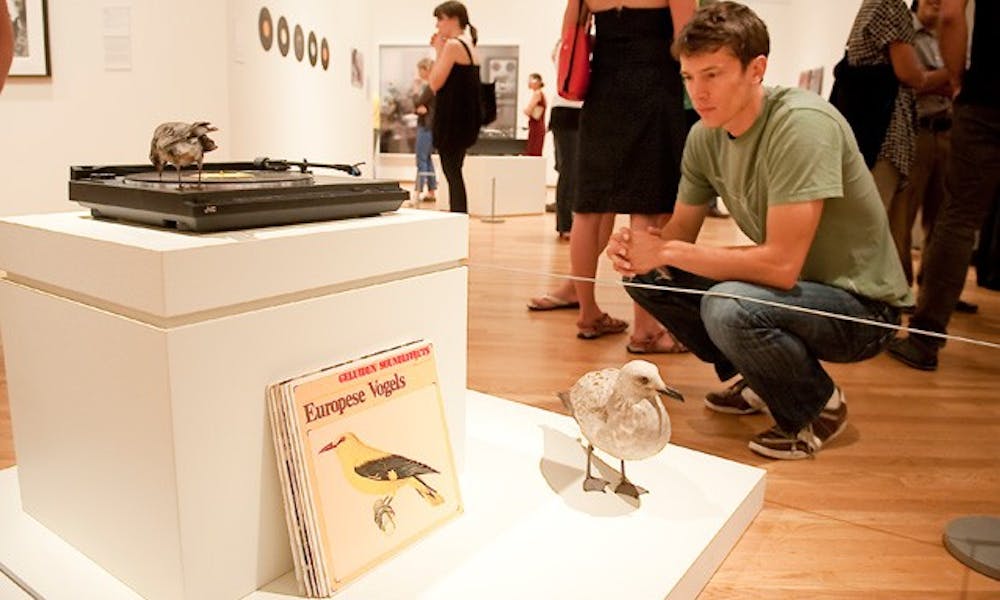Digital files may have superseded vinyl in the mainstream music market, but the record’s influence on the art world is here to stay. The Nasher Museum of Art’s newest exhibition, The Record: Contemporary Art and Vinyl, includes works that draw inspiration from the vinyl record and explore its cultural imprint on society.
Featuring work by 41 artists over the past 50 years, The Record is a multifaceted exhibition and includes drawings, sculptures, performance art, videos, photos, sound work and paintings. The works all use records as the focal point—whether as the artistic medium or as the subject matter—though very few are literal records or album covers, said Wendy Livingston, manager of marketing and communications at the Nasher.
The exhibit was first envisioned in 2005 by Curator of Contemporary Art Trevor Schoonmaker. He said he sifted through 600 to 1,000 works from around 300 different artists.
“I tried to look at as much as possible,” he said. “[There is] so much work out there that engages records. This exhibition is simply about uncovering the artwork and presenting it in a new way.”
Artists range from the well-known to the obscure. Schoonmaker said he chose a wide selection of pieces to expand the metaphorical implications of the exhibit, adding that “the more variety [there is], the better.”
Several pieces from New York-based visual artist Christian Marclay are featured in the collection, including his most recent video on records, “Looking for Love.” Schoonmaker said he would like to acquire one more piece from Marclay, who has worked with records for the past 30 years, before the exhibition finishes its run in February and moves on to its next location in Boston.
Iconic work from artist and Talking Heads co-founder David Byrne is also on display. His featured 7.5-foot Polaroid photomontage was used on the cover of the group’s 1978 album, More Songs About Buildings and Food.
Other memorable pieces include Laurie Anderson’s violin-and-record-player hybrid, William Cordova’s towering stack of records and Taiyo Kimura’s five-minute comedic video, “Haunted by You.”
Japanese artist Lyota Yagi used the idea of records to create his own physical manifestation of the vinyl. In his nine-minute video, he used a silicone mold to create a record of ice, which he then played in a turntable.
“Records can illustrate the passing of time in a very real way,” Yagi said. “Perception is constantly changing. When the ice melts, the sound melts, too.”
Two pieces were commissioned for the exhibition, including Satch Hoyt’s “Celestial Vessel,” a 16-foot canoe made out of red 45 rpm vinyl records, and Xaviera Simmon’s “Thundersnow Road, North Carolina,” which includes photographs of people posing in scenic North Carolina and accompanying songs inspired by the images. Musicians featured in the piece include Superchunk’s Mac McCaughan, My Morning Jacket’s Jim James and TV On the Radio members Kyp Malone, Tunde Adebimpe and Jaleel Bunton.
Schoonmaker said he gave the artists few restrictions in creating their pieces. “I try to give [the artists] a lot of room to work with,” he said. “If you have faith and trust in them, they really do an exceptional job.”
On the flip side, corresponding with so many artists posed the hardest logistical challenge.
“This show required so much research,” Schoonmaker said. “And for every artist, you might have to work with him or her, the assistants... there were hundreds of people you had to coordinate with.”
Although records may never reclaim the popularity of their heyday, they will maintain their significance in the artistic community.
“People like records because they are tactile objects, the visuals are large and they create a warmer, richer sound,” Schoonmaker said.
Livingston said records have timeless, universal appeal and are experiencing a slight resurgence in the music industry.
“People miss vinyl,” she said. “It’s nostalgic, the sound is worn and crackly and you can hold it in your hands. You can’t do that with a download on iTunes.”
Get The Chronicle straight to your inbox
Signup for our weekly newsletter. Cancel at any time.

